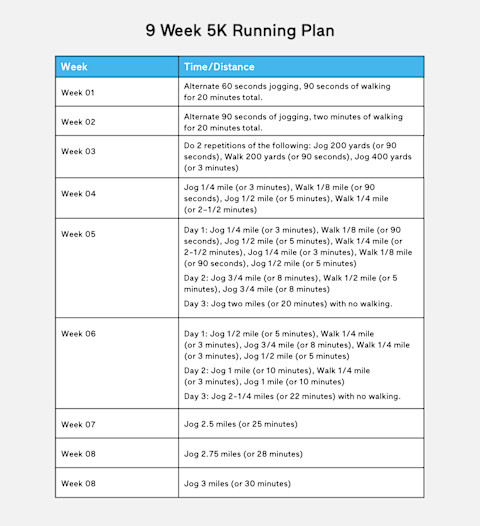
Running is a beneficial and free source of physical fitness, but it's also a great way to take care of mental health1.
While a full marathon may be the ultimate goal for seasoned runners, a 5K is a good place for beginners to start.
The term 5K stands for 5 kilometers, which equals 3.1 miles. Of all the organized long-distance races, 5Ks are typically the shortest.
To help novice runners on their journey, mbg gathered tips and a running plan from a few experts in the sport.
There are many things to consider when it comes to running, like how to start, when to start, and how to practice safety while running.
Beginner tips for running a 5K:
Start small
Running can feel competitive—especially when there's an end goal, like a 5K, in mind.
This can lead runners to take on too much, too quickly in terms of speed and distance, running coach and personal trainer Elizabeth Corkum says. This will lead to soreness and make runners less enthusiastic to get back out there.
"It sounds counterproductive, but spend more time walking," running coach Amanda Brooks says. "It will prevent you from getting frustrated, winded, and injured."
Prepare the night before each run
Finding the motivation to run can be challenging in and of itself. Finding the motivation at the end of a long, tiring day can be even harder.
"It might be really helpful for a new runner to set their running gear out the night before a run," Corkum says. "That way, first thing in the morning, they can just put on their gear and essentially get out the door."
This tip is especially helpful during the summer since mornings are generally the coolest time of day.
Don't quit other forms of exercise
It's important to take breaks from running, even while training. This can reduce risks of overuse and, ultimately, injury.
Corkum suggests continuing aerobic exercises, like swimming, cycling, or rowing.
These activities give the body a break from the motion of running, she explains, while continuing to elevate the heart rate and strengthen the lungs.
For those who don't have access to gym equipment or cardio machines, she recommends going for a walk.
"Not all runners need aerobic cross-training," she says, "but every runner should be doing some sort of strength training, yoga, or stretching practice to keep the body balanced and strong head to toe."
Rest when necessary
Beginner runners and even advanced athletes should take at least one full rest day per week, according to Corkum. "Your body and your brain will thank you, and you'll be more excited to go back to your next training day," she says.
When to start training
Corkum recommends starting to train no later than six weeks before the race.
This leaves enough time to ease into running, Corkum says, but it's also close enough to motivate runners to take training seriously.
For truly beginner runners, Brooks shares her couch-to-5K training plan, which spans nine weeks:
A Nine-Week 5K Training Plan

Before each workout, briskly walk for five minutes.
For the first four weeks, repeat the same workout 3 times per week.
Week 1
Alternate 60 seconds jogging, 90 seconds of walking for 20 minutes total.
Week 2
Alternate 90 seconds of jogging, 2 minutes of walking for 20 minutes total.
Week 3
Do 2 repetitions of the following:
- Jog 200 yards, or 90 seconds
- Walk 200 yards, or 90 seconds
- Jog 400 yards, or 3 minutes
- Walk 400 yards, or 3 minutes
Week 4
- Jog ¼ mile, or 3 minutes
- Walk ⅛ mile, or 90 seconds
- Jog ½ mile, or 5 minutes
- Walk ¼ mile, or 2½ minutes
- Jog ¼ mile, or 3 minutes
- Walk ⅛ mile, or 90 seconds
- Jog ½ mile, or 5 minutes
Week 5
Day 1:
- Jog ¼ mile, or 3 minutes
- Walk ⅛ mile, or 90 seconds
- Jog ½ mile, or 5 minutes
- Jog ½ mile, or 5 minutes
- Jog ¼ mile, or 3 minutes
- Walk ⅛ mile, or 90 seconds
- Jog ½ mile, or 5 minutes
Day 2:
- Jog ¾ mile, or 8 minutes
- Walk ½ mile, or 5 minutes
- Jog ¾ mile, or 8 minutes
Day 3:
- Jog 2 miles, or 20 minutes, with no walking.
Week 6
Day 1:
- Jog ½ mile, or 5 minutes
- Walk ¼ mile, or 3 minutes
- Jog ¾ mile, or 8 minutes
- Walk ¼ mile, or 3 minutes
- Jog ½ mile, or 5 minutes
Day 2:
- Jog 1 mile, or 10 minutes
- Walk ¼ mile, or 3 minutes
- Jog 1 mile, or 10 minutes
Day 3:
- Jog 2¼ miles, or 22 minutes, with no walking.
For the last three weeks, repeat the same exercise 3 times per week.
Week 7
Jog 2½ miles, or 25 minutes
Week 8
Jog 2¾ miles, or 28 minutes
Week 9
Jog 3 miles, or 30 minutes
Safety tips for runners
General ways to practice safety while running include:
- Run with a friend or running group.
- Run on familiar routes, during the daytime when people are around.
- If running in the street, go against traffic.
- Bring a phone and a form of identification.
- If running at night, wear bright or reflective gear.
The takeaway
Running can be challenging, but for those who are interested in picking up the form of fitness, these tips may help.
The nine-week training plan is generalized, but those looking for a more personalized plan may consult a running coach.
